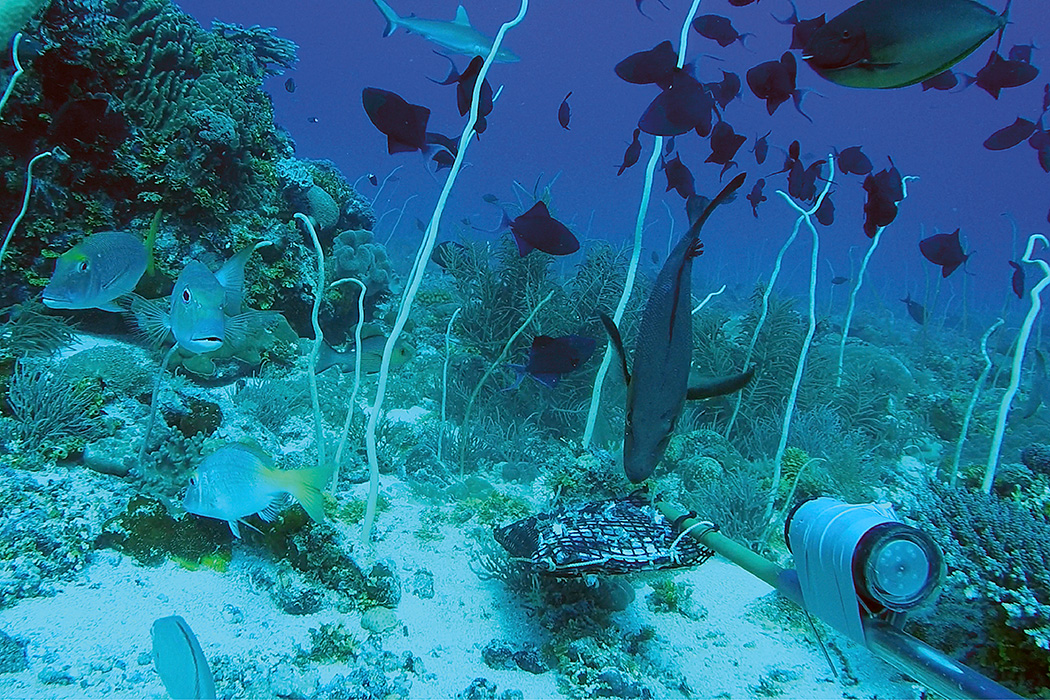
Global S&T Development Trend Analysis Platform of Resources and Environment
| Exceptional fish diversity found on Australia’s north-west oceanic shoals | |
| admin | |
| 2017-03-23 | |
| 发布年 | 2017 |
| 语种 | 英语 |
| 国家 | 澳大利亚 |
| 领域 | 资源环境 |
| 正文(英文) | Scientists have found exceptionally diverse and abundant coral-reef fish communities at submerged oceanic shoals near Ashmore Reef some 400 kilometres off north-western Australia. The north-west oceanic shoals - natural banks that rise from the seabed, in this case from depths of 200 m up to within 15–50 m of the surface - were found to support the highest fish diversity reported globally for deeper ‘mesophotic’ or middle light level coral reefs (20–80 metre depth) and may support the resilience of shallower coral reef communities. The study of nine oceanic shoals in the Timor Sea was led by the Australian Institute of Marine Science (AIMS) and reported recently in Coral Reefs.
“Traditionally scientists and managers have focused on understanding threats to shallow coral reef communities,” says Dr Cordelia Moore, a joint research associate from Curtin University and AIMS. “Deeper reefs beyond the reach of SCUBA-based surveys are poorly studied. Our survey used remote monitoring technologies including multibeam acoustics, photography, towed video, remotely operated vehicles and baited remote underwater systems. We found 341 species of fish from 47 families, including 10 shark, five ray and two sea snake species. The fish communities were 1.4 times as diverse and almost twice as abundant as those on similar deeper coral reefs on the Great Barrier Reef.” The relatively clear waters in the study region allow fauna such as hard corals and macroalgae to grow in depths of up to 60–70 m, supporting diversity similar to shallow reef systems. The fishes may also benefit from enhanced productivity driven by local upwelling and interacting currents. “Characterising these deeper coral-reef communities is critical because mesophotic reefs may provide a unique contribution to biodiversity as well as potentially enhancing the connectivity and resilience of surrounding shallow reefs,” Dr Moore says. While progress has been made understanding the connectivity within and between coral reefs, the degree of connectivity between shallow and deep coral reef populations is largely unknown. Deeper reefs may act as important refugia, providing a source of larvae, juveniles or adults, to replenish more exposed shallow-water reefs after impacts such as coral bleaching, storms and cyclones, fishing pressure and warming events. This is especially important to understand in regions such as north-western Australia, which is experiencing increasing pressures from human activities such as fishing and petroleum industries. “Currently, 30% of north-east Australia’s mesophotic reefs are within no-take management zones of the Great Barrier Reef. In contrast, just 1.3% of Australia's north-west oceanic shoals are in designated no-take areas,” Dr Moore says. “Now that we know these habitats support fish biodiversity of global significance, ensuring we understand and manage these deeper reefs is critical.” The north-west oceanic shoals are of conservation interest at both a regional and global scale. They support many species of conservation interest including the humphead wrasse, greater hammerhead and various sharks, rays and groupers. Australia’s north-west is one of the country’s most economically significant marine regions, producing most of Australia’s domestic and exported oil and gas. It also has high-value ecological habitats supporting a range of protected species such as dugong, turtle and whale sharks. The need for baseline ecological data for this region was highlighted by the 2009 uncontrolled release from the Montara wellhead platform, which triggered monitoring of key ecological communities to ensure the protection and sustainable management of natural and economic values into the future. |
| URL | 查看原文 |
| 来源平台 | Australian Institute of Marine Science |
| 文献类型 | 新闻 |
| 条目标识符 | http://119.78.100.173/C666/handle/2XK7JSWQ/233029 |
| 专题 | 资源环境科学 |
| 推荐引用方式 GB/T 7714 | admin. Exceptional fish diversity found on Australia’s north-west oceanic shoals. 2017. |
| 条目包含的文件 | 条目无相关文件。 | |||||
| 个性服务 |
| 推荐该条目 |
| 保存到收藏夹 |
| 查看访问统计 |
| 导出为Endnote文件 |
| 谷歌学术 |
| 谷歌学术中相似的文章 |
| [admin]的文章 |
| 百度学术 |
| 百度学术中相似的文章 |
| [admin]的文章 |
| 必应学术 |
| 必应学术中相似的文章 |
| [admin]的文章 |
| 相关权益政策 |
| 暂无数据 |
| 收藏/分享 |
除非特别说明,本系统中所有内容都受版权保护,并保留所有权利。
修改评论